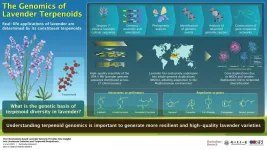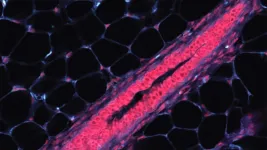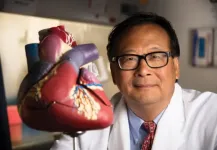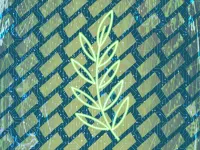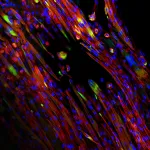Simple surgery prevents strokes in heart patients
Removing left atrial appendage cuts the risk of strokes by more than one-third in patients with atrial fibrillation
2021-05-15
(Press-News.org) Hamilton, ON (May 15, 2021) - A simple surgery saves patients with heart arrhythmia from often-lethal strokes, says a large international study led by McMaster University.
Researchers found that removing the left atrial appendage -- an unused, finger-like tissue that can trap blood in the heart chamber and increase the risk of clots -- cuts the risk of strokes by more than one-third in patients with atrial fibrillation.
Even better, the reduced clotting risk comes on top of any other benefits conferred by blood-thinner medications patients with this condition are usually prescribed.
"If you have atrial fibrillation and are undergoing heart surgery, the surgeon should be removing your left atrial appendage, because it is a set-up for forming clots. Our trial has shown this to be both safe and effective for stroke prevention," said Richard Whitlock, first author of the study.
"This is going to have a positive impact on tens of thousands of patients globally."
Whitlock is a scientist at the Population Health Research Institute (PHRI), a joint institute of McMaster University and Hamilton Health Sciences (HHS); a professor of surgery at McMaster, the Canada Research Chair in cardiovascular surgical trials, a cardiac surgeon for HHS, and is supported by a Heart and Stroke Foundation career award.
The co-principal investigator of the study is Stuart Connolly who has also advanced this field by establishing the efficacy and safety of newer blood thinners. He is a professor emeritus of medicine at McMaster, a PHRI senior scientist and a HHS cardiologist.
"The results of this study will change practice right away because this procedure is simple, quick and safe for the 15 per cent of heart surgery patients who have atrial fibrillation. This will prevent a great burden of suffering due to stroke," Connolly said.
The study results were fast tracked into publication by The New England Journal of Medicine and presented at the American College of Cardiology conference today.
The study tracked 4,811 people in 27 countries who are living with atrial fibrillation and taking blood thinners. Consenting patients undertaking cardiopulmonary bypass surgery were randomly selected for the additional left atrial appendage occlusion surgery; their outcomes compared with those who only took medicine. They were all followed for a median of four years.
Whitlock said it was suspected since the 1940s that blood clots can form in the left atrial appendage in patients with atrial fibrillation, and it made sense to cut this useless structure off if the heart was exposed for other surgery. This is now proven to be true.
Atrial fibrillation is common in elderly people and is responsible for about 25 per cent of ischemic strokes which are caused when blood clots block arteries supplying parts of the brain. The average age of patients in the study was 71.
"In the past all we had was medicine. Now we can treat atrial fibrillation with both medicines and surgery to ensure a much better outcome," said Whitlock.
He said that the current study tested the procedure during cardiac surgery being undertaken for other reasons, but the procedure can also be done through less invasive methods for patients not having heart surgery. He added that future studies to examine that approach will be important.
Whitlock said the left atrial appendage is a leftover from how a person's heart forms as an embryo and it has little function later in life.
"This is an inexpensive procedure that is safe, without any long-term adverse effects, and the impact is long-term."
INFORMATION:
External funding for the study came from the Canadian Institutes of Health Research and the Heart and Stroke Foundation of Canada.
Editors:
Pictures of Drs Richard Whitlock and Stuart Connolly may be found at: https://macdrive.mcmaster.ca/d/ded01db1d99a4632af27/
For information, please contact:
Veronica McGuire
Media Relations
Faculty of Health Sciences
McMaster University
289-776-6952
vmcguir@mcmaster.ca
[Attachments] See images for this press release:
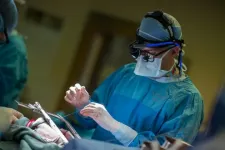
ELSE PRESS RELEASES FROM THIS DATE:
2021-05-15
Researchers at Rutgers Robert Wood Johnson Medical School are reporting the first instance of COVID-19 triggering a rare recurrence of potentially serious blood clots in people's arms.
The discovery, published in the journal Viruses, improves the understanding of how inflammation caused by COVID-19 can lead to upper extremity blood clots and how best to treat them. The case study is part of a larger Rutgers study of 1,000 hospitalized patients diagnosed with COVID-19 who were admitted and discharged between March and May 2020.
While there have been reports of lower extremity deep vein thrombosis following COVID-19, ...
2021-05-14
Next-generation sequencing technology has made it easier than ever for quick diagnosis of plant diseases. "It's really exciting to see how sequencing technologies have evolved and how this new technology facilitates sequencing of entire genomes in such a short amount of time," said Yazmín Rivera, a plant pathologist with the United States Department of Agriculture's Plant Protection and Quarantine program, who recently published a research paper on the efficacy of Oxford Nanopore Technologies protocols.
"We wanted to provide an unbiased assessment of the technology and protocols available for long read sequencing," Rivera explained. Along with other plant pathologists, Rivera used the company's protocols to prepare RNA and DNA libraries from virus-infected plant material ...
2021-05-14
People with a high polygenic risk score for colorectal cancer could benefit more at preventing the disease by leading healthy lifestyles than those at lower genetic risk, according to a study by Vanderbilt researchers published in the April issue of The American Journal of Clinical Nutrition.
Analyzing data from participants in the UK Biobank, the researchers estimated that maintaining a healthy lifestyle was associated with a nearly 40% reduction in colorectal cancer risk among those with a high genetic risk of developing the disease. The percentage dropped to only about 25% among people at ...
2021-05-14
Dozens of commonly used drugs, including antibiotics, antinausea and anticancer medications, have a potential side effect of lengthening the electrical event that triggers contraction, creating an irregular heartbeat, or cardiac arrhythmia called acquired Long QT syndrome. While safe in their current dosages, some of these drugs may have a more therapeutic benefit at higher doses, but are limited by the risk of arrhythmia.
Through both computational and experimental validation, a multi-institutional team of researchers has identified a compound that prevents the lengthening of the heart's electrical event, or action potential, resulting in a major step toward safer use and expanded therapeutic efficacy of these ...
2021-05-14
Extracting hydrogen from water through electrolysis offers a promising route for increasing the production of hydrogen, a clean and environmentally friendly fuel. But one major challenge of water electrolysis is the sluggish reaction of oxygen at the anode, known as the oxygen evolution reaction (OER).
A collaboration between researchers at Hunan University and Shenzhen University in China, has led to a discovery that promises to improve the OER process. In their recent paper, published in the KeAi journal Green Energy & Environment, they report that etching - or, in other words, chemically removing - the oxide overlayers that form on the surface of the metal phosphide electrocatalysts regularly used in electrolysis, can increase ...
2021-05-14
Even the mention of lavender evokes the distinct fragrance of the flower. This beautiful flower has been used to make perfumes and essential oils since time immemorial. The aesthetics of the flower have captured the imagination of hundreds, worldwide. So, what makes this flower so special? What are the "magical" compounds that gives it its unique fragrance? What is the genetic basis of these compounds? These questions have long puzzled scientists.
To find out the answers, a group of scientists from China have sequenced the genome of lavender, which is known in the scientific world as Lavandula angustifolia. The team headed by Dr. Lei Shi, Professor at the Key Laboratory of Plant Resources and Beijing Botanical Garden, Institute of Botany, Chinese ...
2021-05-14
What if you could predict which cells might become cancerous? Breast tissue changes dramatically throughout a woman's life, so finding markers for sudden changes that can lead to cancer is especially difficult. Cold Spring Harbor Laboratory (CSHL) Associate Professor Camila dos Santos and her team identified and cataloged thousands of normal human and mouse breast cell types. The new catalog redefines healthy breast tissue so that when something goes awry, scientists can pinpoint its origin.
Any breast cell could become cancerous. Dos Santos says:
"To understand breast cancer risk, you have to understand normal breast cells first, so when we think about preventive and even targeting therapies, ...
2021-05-14
BIRMINGHAM, Ala. - In a large-animal study, researchers have shown that heart attack recovery is aided by injection of heart muscle cells derived from human induced pluripotent stem cell line, or hiPSCs, that overexpress cyclin D2. This research, published in the journal Circulation, used a pig model of heart attacks, which more closely resembles the human heart in size and physiology, and thus has higher clinical relevance to human disease, compared to studies in mice.
An enduring challenge for bioengineering researchers is the failure of the heart to regenerate muscle tissue after a heart attack has killed part of its muscle wall. That dead tissue can strain the surrounding muscle, leading to a lethal heart enlargement.
Heart experts thus have sought to create new tissue -- applying ...
2021-05-14
Inspired by nature, researchers at Pacific Northwest National Laboratory (PNNL), along with collaborators from Washington State University, created a novel material capable of capturing light energy. This material provides a highly efficient artificial light-harvesting system with potential applications in photovoltaics and bioimaging.
The research provides a foundation for overcoming the difficult challenges involved in the creation of hierarchical functional organic-inorganic hybrid materials. Nature provides beautiful examples of hierarchically structured hybrid materials such as bones and teeth. These materials typically showcase a precise atomic ...
2021-05-14
HOUSTON - (May 14, 2021) - Rice University bioengineers are fabricating and testing tunable electrospun scaffolds completely derived from decellularized skeletal muscle to promote the regeneration of injured skeletal muscle.
Their paper in Science Advances shows how natural extracellular matrix can be made to mimic native skeletal muscle and direct the alignment, growth and differentiation of myotubes, one of the building blocks of skeletal muscle. The bioactive scaffolds are made in the lab via electrospinning, a high-throughput process that can produce single micron-scale fibers.
The research could ease the burden of performing an estimated ...
LAST 30 PRESS RELEASES:
[Press-News.org] Simple surgery prevents strokes in heart patients
Removing left atrial appendage cuts the risk of strokes by more than one-third in patients with atrial fibrillation




